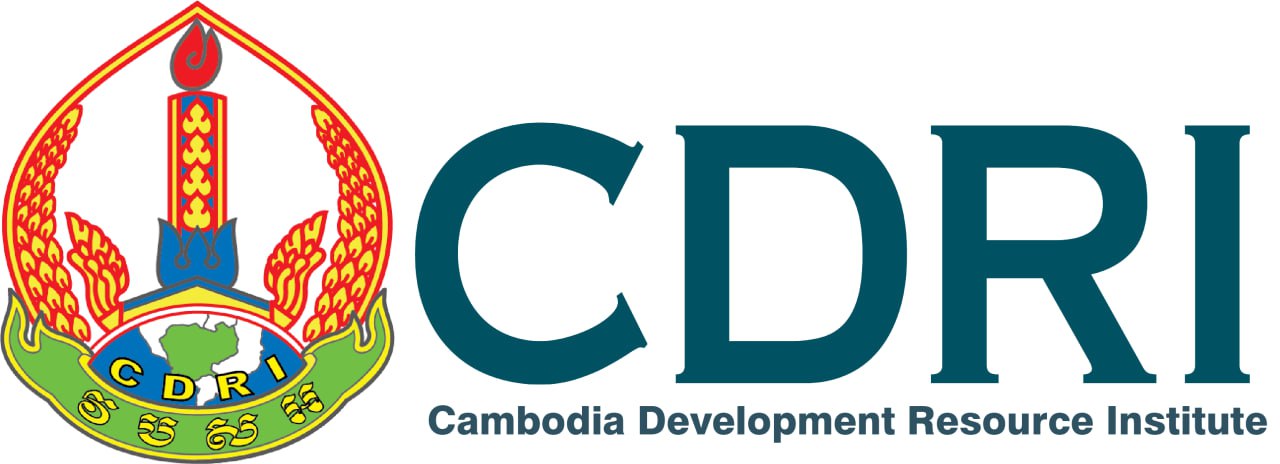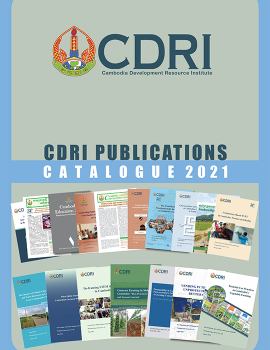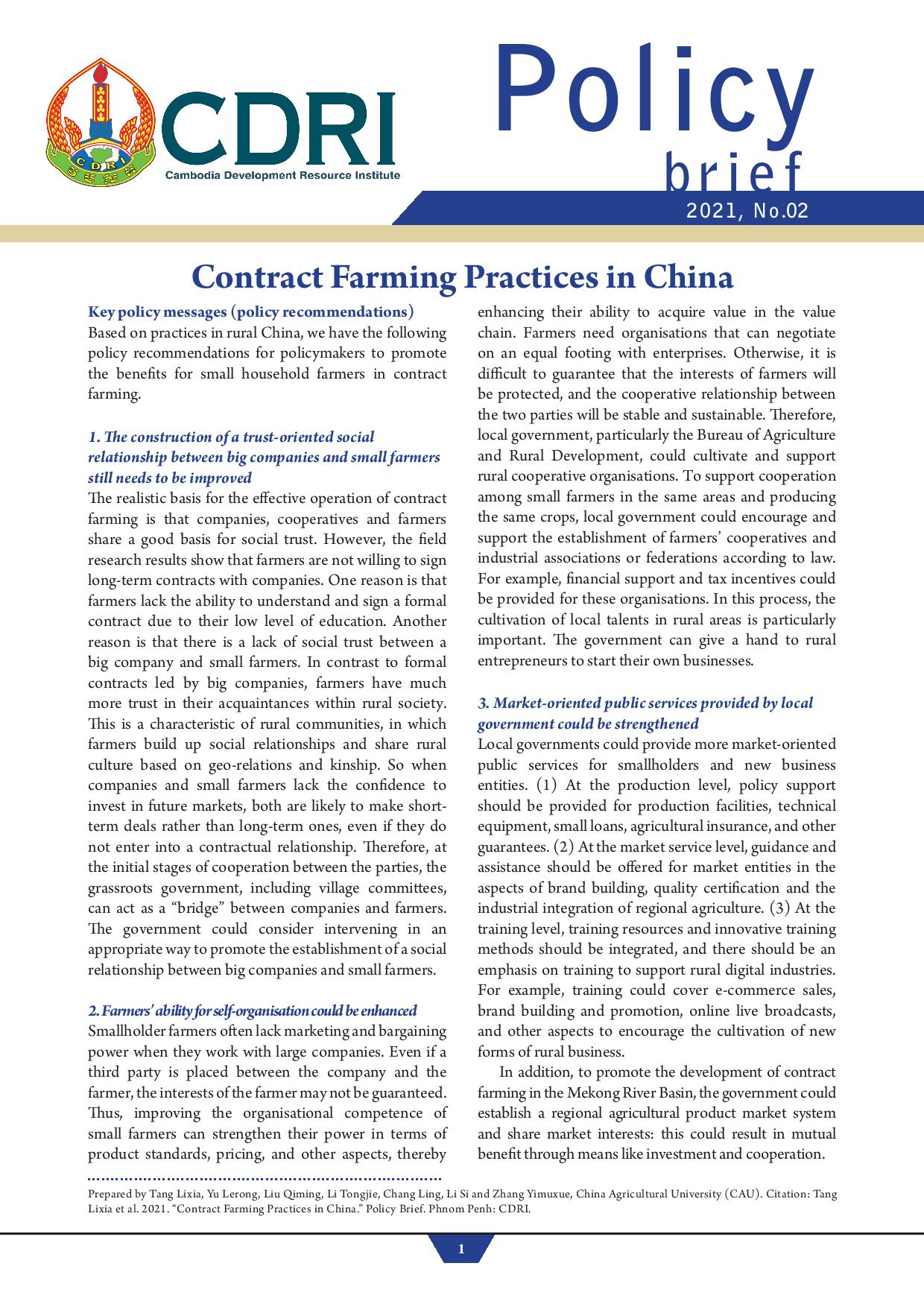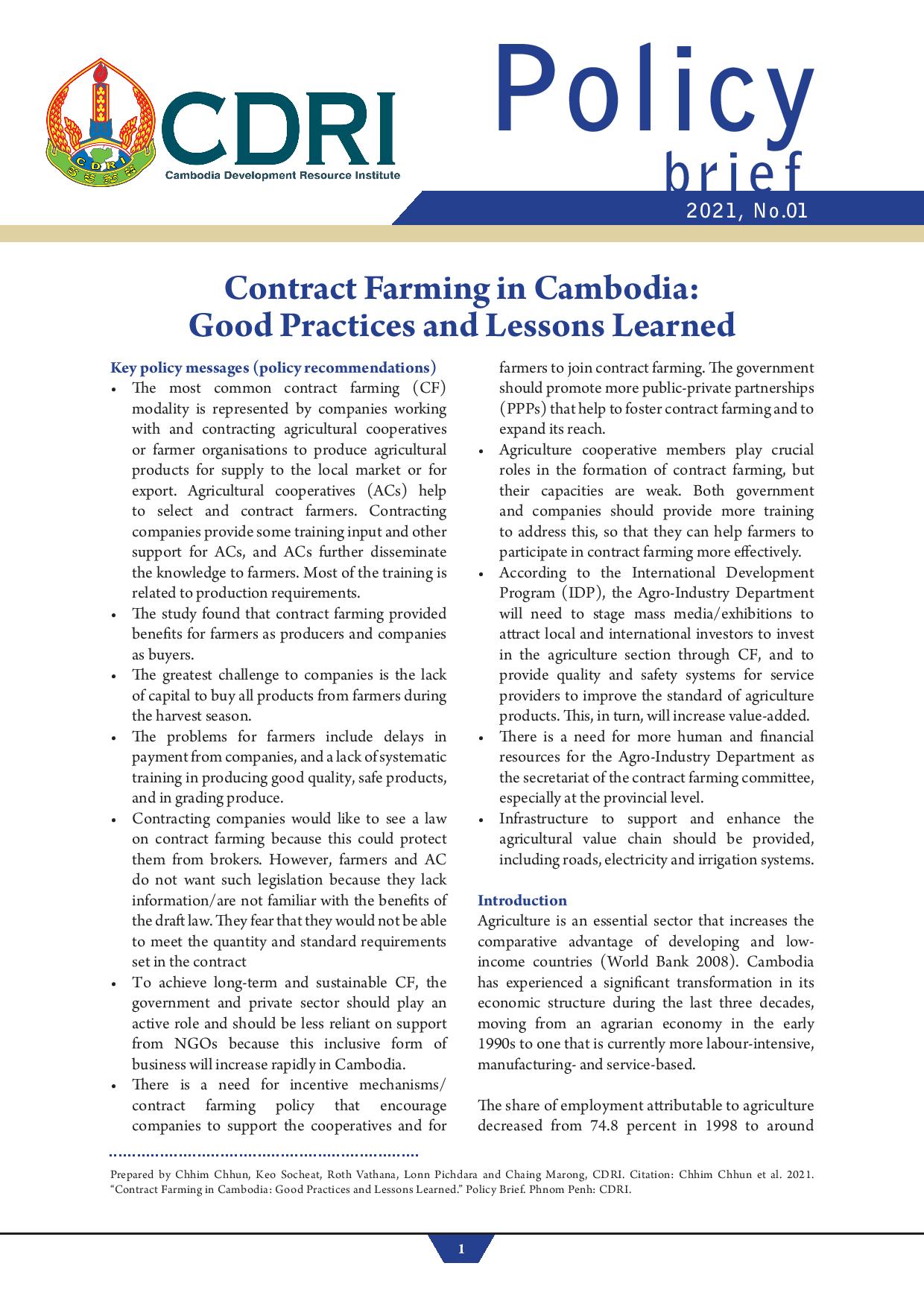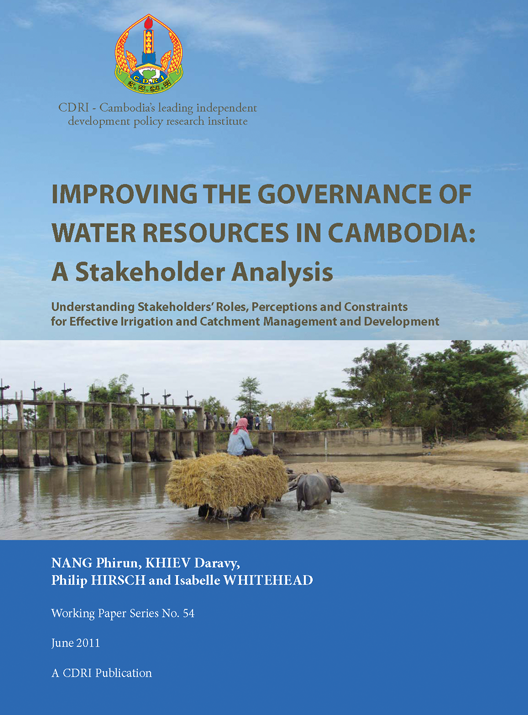
Improving the Governance of Water Resources in Cambodia: A Stakeholder Analysis
Abstract/Summary
Irrigation development and management of water resources present
serious governance challenges for many stakeholders in Cambodia. Farmers,
government agencies, development organisations and the private sector all have
a role to play, yet their roles and responsibilities are not always well
defined. Contemporary ideas on water governance indicate a greater need for participation
and ownership of local resources by the communities that use those resources.
As such, there is a need to refine and rethink the way in which key
stakeholders relate to each other and make decisions on the use of water for
irrigation.
This paper analyses stakeholder roles, relationships and
perspectives with respect to Cambodia’s water resources management, with a
specific focus on irrigation and catchment management. It also examines the
degree of consistency or disparity between different stakeholders, and between
formal stakeholder roles and actual practices. Data from key informant
interviews, field observations, focus group discussions (FGDs) and
dissemination workshops have been analysed to draw out the main issues relating
to water governance stakeholders and to resolve knowledge gaps. It examines water-related
institutions and stakeholder agencies in depth to gain an understanding of
their current capacity and potential. The research findings are presented in a
way that will assist public policy decision-makers to compare and evaluate
policy alternatives.
Several theoretical approaches guided this study, one of which is
the stakeholder typology. Developed as part of the analysis, this perspective
has enabled a broad definition of stakeholders in terms of their relative power
(influence), legitimacy (interest) and urgency. The analysis is also broadly
informed by existing literature on stakeholder relationships and governance
mechanisms, especially as they relate to water governance. This includes
Integrated Water Resources Management (IWRM), which advocates for the proper
coordination and active participation of stakeholders from all relevant
sectors. Its underlying assumption is to consider the social, cultural,
political, economic and ecological aspects of water as being interrelated and
equally valuable.
Findings
The study found that irrigation schemes and rural infrastructure
in Cambodia are often jointly funded by the government and external donors,
with in-kind contributions (such as land and labour) from project
beneficiaries. Water-related issues are handled by several overlapping
ministries and committees with differing, yet specific, mandates, ambitions and
policies. Responsibilities for water resources policy and planning are
increasingly delegated to sub-national authorities and the Provincial
Department of Water Resources and Meteorology (PDOWRAM). This decentralisation of
water management is consistent with the government’s wider process of
sub-national governance reform, recognising the need to introduce new systems
of governance at provincial, municipal and district levels.
The present water governance system, however, is challenged by the
lack of effective feedback mechanisms and coordination among the different
levels of government. Urgent improvements are needed to improve the functioning
of vertical governance mechanisms linking central government, provincial and
local authorities and villages, as well as to improve horizontal governance
mechanisms in support of decision-making across different departments, commune
and village level authorities. For the reforms to be implemented effectively,
the responsibilities of government, especially the Ministry of Water Resources
and Meteorology (MOWRAM), PDOWRAM, donors, local authorities (LAs), Farmer
Water User Communities (FWUCs) and farmers, need to be clear.
Participatory Irrigation Management and Development (PIMD) is
being introduced in recognition of the need for greater community participation
to improve the performance of irrigation systems.1 In the context of Cambodia,
PIMD suggests that FWUCs assume the primary responsibility and authority to
manage, repair and improve existing irrigation systems, and to promote and
guide the development of new irrigation systems. PIMD is accepted as a national
policy in Cambodia and a core strategy to promote participation by farmers in
the management of irrigation schemes.
The sustainability of
irrigation management relies mainly on the performance of farmers and FWUCs,
with technical and financial assistance from concerned institutions such as
MOWRAM, PDOWRAM, donors and civil society organisations (CSOs). Village level
findings indicate, however, a significant disparity between the FWUC’s formal
mandate and its actual effectiveness. Although FWUCs have been granted legal
and administrative responsibility for managing irrigation schemes, the way that
this has been implemented means that most farmers do not feel a strong sense of
ownership over the projects/schemes, and continue to seek LAs’ and PDOWRAM’s
assistance to solve their water issues. The perception that the schemes are not
fully functional also makes it difficult for the FWUCs to collect irrigation
service fees (ISF) necessary for the scheme to remain operational. The lack of
community ownership over irrigation schemes is exacerbated by a perceived lack of
legitimacy of the FWUCs, caused by difficulties and delays with their
registration. Also, despite being independent organisations with a mandate to
coordinate and facilitate local waterrelated issues, FWUCs are hampered by the
fact that they do not have conflict resolution powers. FWUCs have to coordinate
and negotiate with LAs, government institutions and other external organisations
in order to carry out their basic functions.
A range of stakeholders have financed the development and
management of irrigation systems, but sustainable financial arrangements to
support the operation and maintenance of these systems are still lacking. From
1979 to the present, large amounts of funds from the national budget, bank loans
and donor funds have been directed to rehabilitate, construct and maintain
irrigation systems, establish flood protection dykes and install pumping
stations. Financial sustainability of water service delivery should be
achievable because the service to identified users is levied. Many FWUCs
report, however, that the ISF does not cover the cost of operation and
maintenance (O&M). To solve this, the FWUCs have sought financial support
from the government, especially from MOWRAM and PDOWRAM, as well as various
funding agencies. This has led the government to encourage the private sector,
NGOs, international organisations, development partners and donors to invest in
and develop small, medium and large scale irrigation systems and pay for their
O&M.
Better management of water resources in a river basin context
requires effective water governance policy reflecting accountability,
transparency, equity and public participation, with a strong commitment from
all stakeholders. An improved water governance system developed under the
existing legal framework at river basin level would, in turn, support the
capacity of FWUCs, LAs and local institutions to sustainably manage water
resources in a wider social and environmental context.
The implementation of IWRM, PIMD, Irrigation Management Transfer
(IMT)3 and the formation of the FWUCs needs to be undertaken carefully at local
level taking into account the existing political, cultural, socio-economic
and physical features of each specific area. The coordination and
decentralisation work in local communities, however, remains slow, particularly
in the water governance sector, and will need to improve over a period of time
if it is to reach its desired goals. In many areas of the Tonle Sap Basin
(TSB), local people and communities still rely on the coordination or support
of local political hierarchies, such as the commune councils (CCs), district governors
and concerned institutions, to make important decisions. The Technical Working
Group on Agriculture and Water (TWGAW) also acknowledges that some of the
functions of stakeholders are poorly coordinated and there are gaps and
overlaps in functions which need to be remedied within the present public
administration reforms.
In addition to the need for an improved coordination structure and
a more accountable governance system, considerable investment is also needed to
improve the physical infrastructure of existing irrigation schemes. The
irrigation systems will not be technically and financially feasible unless they
are fully operational and provide real and timely profits to farmers.
Recommendations
As part of the participatory approach to this study, stakeholders
were asked to propose practical solutions that could address their concerns.
They described the need for greater technical support and greater clarity at
local levels about the role and nature of IWRM and its relationship to other
policies such as Decentralisation and Deconcentration (D&D) and PIMD.
Although these policies have been implemented at national level, they have not
yet been fully implemented in local communities. Successful implementation of
these national initiatives is dependent on the strength of local governance structures,
local leadership, management capacity and technical expertise.
The research has arrived at the conclusion that there needs to be
some kind of structure to improve coordination at catchment or provincial level
which could also increase the technical expertise available to support FWUCs,
line agencies and other groups without removing their authority to make
decisions about their own resources. On the basis of the stakeholder responses,
this paper outlines a new coordination structure at sub-national level, which
is referred to as the Irrigation and Catchment Management Sub-committee
(ICMSC).
There are a number of different forms that the sub-committee could
take. To stimulate informed discussion and allow for flexibility, the
recommendations below explain the aims and functions of the sub-committee and
identify the key options and considerations to setting up said sub-committee. The
considerations ensure that past lessons inform the development of the new
structure and that the changes support rather than duplicate existing
structures or resources. It is also to stimulate discussion towards a consensus
about how the proposed sub-committee can be given an effective mandate and
remain transparent without diminishing the important local role and authority
of the newly established FWUCs.
These policy recommendations were discussed during the community
level consultations and refined through a series of provincial level workshops
with farmers, FWUCs and representatives from PDOWRAM. They aim to address fundamental
issues relating to the local implementation of D&D policy and IWRM as
identified in the stakeholder analysis.
Recommendation 1: Irrigation and Catchment Management
Sub-committee (ICMSC)
Create Irrigation and Catchment Management Sub-committees (ICMSCs)
at sub-national level to support the coordination of FWUCs, provincial
departments and LAs in making decisions on integrated water resources,
planning, development and management at catchment level. The subcommittee would
assist in building a common understanding among FWUCs, LAs, and provincial departments
about IWRM and D&D policy and support the spatial integration of upstream
and downstream communities. They would provide a basis for the development of
the new governance structures anticipated under the government’s River Basin
Management Policy.
Functions of ICMSCs
The ICMSCs would:
·
Promote ‘bottom-up’ processes for small and medium scale
irrigation scheme management and development projects within a river basin
context taking into account the principles of IWRM, the interests of all
stakeholders and the sustainability of natural resources;
·
Collaborate with concerned institutions (MOWRAM, MAFF, PDOWRAM,
PDAFF), CSOs, provincial governors, LAs, academic and research centres (CDRI,
the Institute of Technology of Cambodia (ITC), the Royal University of Phnom
Penh (RUPP), the Royal University of Agriculture (RUA), foreign universities)
and donors (Asian Development Bank (ADB), Agence Française de Développement
(AFD), the World Bank (WB), Japanese International Cooperation Agency (JICA))
to seek technical and financial support;
·
Provide an avenue to
channel additional technical expertise, including inter-disciplinary advice
from different provincial departments, NGOS, donors and external experts on hydrology
and IWRM so that the sub-committee may function as a ‘service centre’ for the FWUCs;
·
Offer a forum to raise
funds and receive advice from NGOS and donors;
·
Provide an opportunity to resolve conflicts between schemes and
for FWUCs to jointly plan their cropping and harvesting activities through an
informed process based on hydrological and social knowledge;
·
Conduct monitoring, evaluation and impact assessment of water
related activities, water policies and the effectiveness of sub-committee
activities using a participatory approach.
Considerations
In determining the governance structure of the
ICMSC, careful consideration should be given to the following:
·
Lead agency and sub-committee members: Determining the appropriate
government agency and level to lead the sub-committee is important.
Consideration should be given to whether it is best managed at provincial or
catchment level, and whether a given line agency should chair the sub-committee
or whether this would be best done by the provincial office, taking into
account the government’s national policies on IWRM and D&D reform.
·
Mandate and authority: The sub-committee needs a full and
effective mandate but one that is transparent and does not usurp the
decision-making powers of FWUCs and other relevant agencies. Mechanisms for
downward accountability are important so that the FWUCs are represented, are
able to access the technical and financial support that is channelled through the
sub-committee, and are able to call on the sub-committee to exercise authority
when negotiation, arbitration and coordination between FWUCs is required. It
may be necessary for the sub-committee to have an advisory role rather than
full authority in deciding on water allocation at scheme and catchment level,
so that local communities retain ultimate control over key decisions.4
·
Variation between catchments and schemes: Situating the
sub-committee at a provincial/ catchment level provides a more context-specific
structure in which FWUCs, LAs and provincial departments could muster the
authority to make decisions about water resources and irrigation. However, in
each location the sub-committee may take a different “shape”, depending on the
nature of the catchment and the capacity of existing stakeholders. The structure
of each ICMSC will depend on the capacity/ expertise in each location and may need
to be tailored to individual catchments depending on whether they appropriately
overlap with provincial government jurisdictions.
·
Further stakeholder
consultation: A sub-committee should only be established once there has been a
process of joint study, action or consultation. They should not be imposed simultaneously
as “shells” without underlying stakeholder involvement. The establishing of a
sub-committee requires facilitation which is integral to their success.
Recommendation
2: Education and Training
Provide training to local stakeholders,
especially PDOWRAM staff, commune councils, farmers and FWUC committee members
on important laws and policies, so that they are aware of their rights and
duties when using natural resources. The training should cover:
·
Water, Forestry, Fishery, Land and Environment Law;
·
D&D and PIMD policies;
·
Organic Law5;
·
Administrative regulations
and guidelines.
Recommendation
3: Building Local Management Leadership and Capacity
Build the
capacity of FWUC committees and commune councils so that they manage their resources
properly and are able to lead their communities well. Greater capacity is
needed in relation to:
·
Leadership, facilitation and communication skills;
·
Budget allocation and
financial management;
·
Natural resources
management;
·
Project development and
management;
·
Irrigation and farming
systems.
Recommendation
4: Improving FWUC Accountability
Improve FWUC and LA accountability through
strong organisational coordination. FWUC committees have to work according to
the roles and duties set in its statute, despite the limited support funds. Key
areas to take into account include:
·
Encouraging farmers to be aware of the importance of ISF and to
satisfactorily participate in O&M for sustainable irrigation systems;
·
Informing and engaging farmers to participate in irrigation
management and development early and at every stage;
·
Expanding the profit of irrigation to farmers by seeking new
suitable technology for water management and agricultural extension so that
farmers get more products and income;
·
Providing timely water and agricultural information and engaging
farmers to value common interests.
Considerations
Some FWUCs have
raised the issue that if the scheme infrastructure and management capacity are
not improved to meet farmers’ expectations regarding the availability of water
through the scheme, then there may be additional difficulties in increasing
accountability, compliance and participation.
Recommendation
5: Greater Coordination of the Tonle Sap Basin
Decentralisation
in water resources management cannot be achieved if stakeholders, especially farmers,
are not well informed and do not participate in protecting and maintaining
their common property. Some important issues that LAs and concerned institutions
within the Tonle Sap Basin should consider are:
·
Working towards a shared understanding of D&D and PIMD
principles among stakeholders;
·
Delegating appropriate levels of responsibilities such as
planning, implementation, management and decision making in water resources
management and development to local level communities (FWUCs), CSOs, and the
private sector, etc to increase local involvement;
·
Allocating operational and administrative funds to support local
level community functions including accountability and financing or
co-financing; and
·
Reforming and improving stakeholder participation at the Tonle Sap
Basin level, beyond the sub-committee members, by increasing coordination with
local communities, CSOs, private sector and provincial line agencies to
prioritise critical and urgent issues and provide a timely and reasonable
response to them.
Recommendation 6: Proposed Further Research
The case studies and workshops in the three provinces suggested
that the integration of CC members in the structure of the FWUCs (as FWUC
committee members) would help to maintain the legal functions and operation of
the FWUCs. Some local stakeholders mentioned that this integration may also
build up the role and accountability of the FWUC committees by:
·
Empowering FWUCs in their irrigation management roles;
·
Facilitating and coordinating with key relevant stakeholders;
·
Enhancing the sharing of information on water and agricultural
policy;
·
Improving the quality of planning and decision making in
investment /development projects; and
·
Reducing potential conflict between LAs and increasing public
trust and participation. In the above regard, future research could address the
following:
·
How can FWUCs and CCs improve farmer participation or
community-based approaches in water resource management to ensure the
sustainability of irrigation schemes?
·
In the context of irrigation and catchment governance, how can
PIMD and D&D policies be adapted and implemented effectively?
·
How can government-donor-community-private sector partnerships in
irrigation water management be developed? What are the most effective
mechanisms to strengthen such partnerships?
·
Should CC members be included in the management structures of FWUC
committees to provide technical support and authority?
